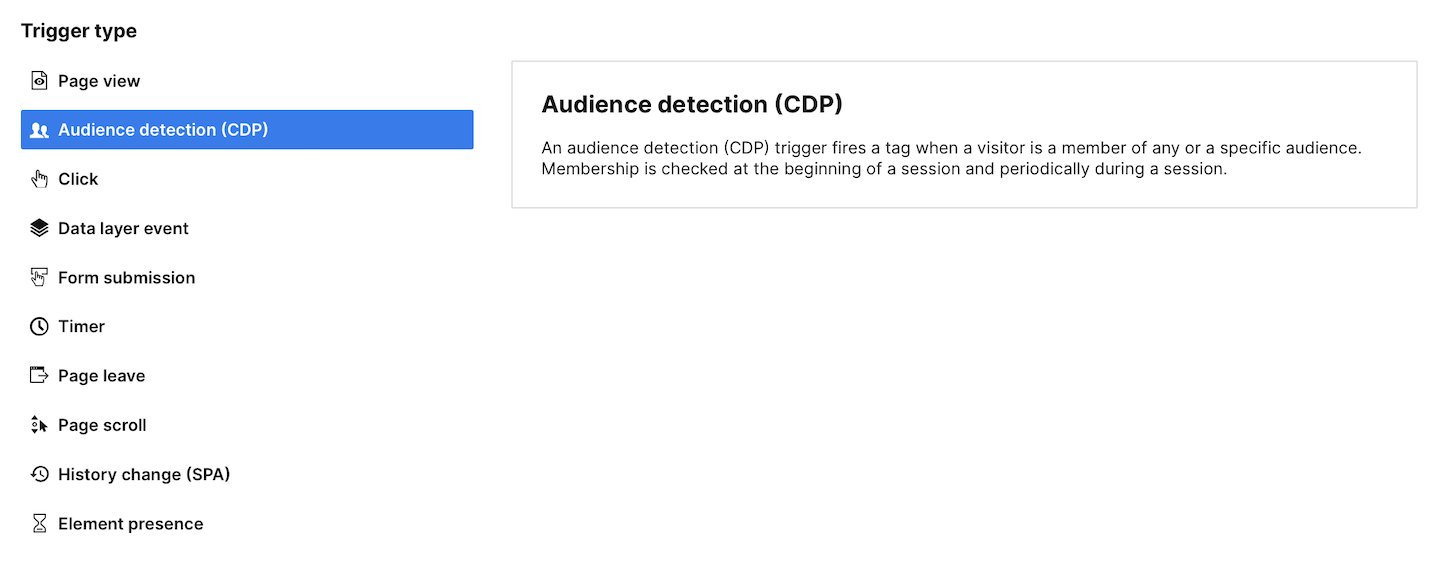An audience detection (CDP) trigger fires a tag when a visitor is a member of any or a specific audience. Membership is checked at the beginning of a session and periodically during the session.

Here’s a list of conditions available in this trigger.
| Condition type | Description | Example |
|---|---|---|
| Page URL | Fires the tag when a visitor is a member of any or a specific audience and visits a page with the selected page URL. For example, a visitor is a member of the Apple users audience and visits https://clearbank.com/product-tour/. |
Page Url equals https://clearbank.com/product-tour/ |
| Page path | Fires the tag when a visitor is a member of any or a specific audience and visits a page with the selected page path. For example, a visitor is a member of the Apple users audience and visits /product-tour. |
Page Path contains /product-tour |
| Page hostname | Fires the tag when a visitor is a member of any or a specific audience and visits a page on a website with the selected hostname. For example, a visitor is a member of the Apple users audience and visits a page hosted on clearbank.com. |
Page Hostname equals clearbank.com |
| History source |
Fires the tag when a visitor is a member of any or a specific audience and a specific history event occurs ( For more on the |
History source equals pushState |
| History fragment | Fires the tag when a visitor is a member of any or a specific audience and visits a page where the hash in the page URL matches the selected condition. |
Example URL: https://example.com/#pricing |
| Old history fragment |
Fires the tag when a visitor is a member of any or a specific audience and visits a page where the previous hash in the page URL matches the selected condition. For more on the |
Example previous URL: https://example.com/#about-us |
| History state |
Fires the tag when a visitor is a member of any or a specific audience and visits a page where the history state in the page URL matches the selected condition. For more on the |
or
|
| Old history state |
Fires the tag when a visitor is a member of any or a specific audience and visits a page where the previous history state in the page URL matches the selected condition. For more on the |
or
|
| Referrer | Fires the tag when a visitor is a member of any or a specific audience and visits a page to which they were directed by the selected referrer. This referrer is internal, meaning that it belongs to the same domain as your site. For example, a visitor is a member of the Apple users audience and comes from https://clearbank.com/blog. |
Referrer equals https://clearbank.com/blog |
| External referrer | Fires the tag when a visitor is a member of any or a specific audience and comes to your site from the selected referrer. This referrer is external, meaning that it has a different domain than your site. For example, a visitor is a member of the Apple users audience and comes from https://google.com. |
External referrer equals https://google.com |
| Campaign | Fires the tag when a visitor is a member of any or a specific audience and comes to your site from the selected campaign (based on the utm_campaign parameter). | Campaign equals winter-promo |
| Traffic source |
Fires the tag when a visitor is a member of any or a specific audience and comes to your site from the selected traffic source. Possible values: campaign, organic search, social, referral, direct. |
Traffic source equals direct |
| Returning visitor | Fires the tag when a visitor is a member of any or a specific audience and is a returning visitor. The returning visitor is recognized by Tag Manager, which uses the stg_returning_visitor cookie. | Returning visitor is true |
| Variable-based conditions | Any variable you add will appear in the list of conditions and you can use it to define trigger conditions. | – |
